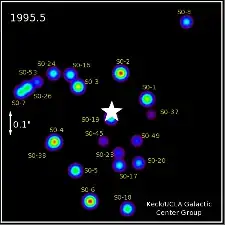We have images of stars orbiting black holes or black holes destroying near stars, but why do we see the stars moving normally? I mean, if time dilation does exist, shouldn't we see that stars slow down and speed up? Why do we see stars orbiting at a normal rate?
3 Answers
Those objects are orbiting closely to SgrA${}^{*}$, certainly, but they are not orbiting closely enough to exhibit significant time dilation effects. In particular, consider the Schwarzschild spacetime. The inner most stable circular orbit around the central obect is at $r = 6M$, three Schwarzschild radii away. This makes the time dilation factor:
$$\sqrt{1-\frac{2M}{r}}= \sqrt{1-1/3} = \sqrt{2/3} = .82$$
So, even the farthest in stable orbit is only running 18% slower than a distant clock. You can cheat at this a bit by giving the central black hole spin, which will draw in the innermost orbit, but generically, you don't see huge time dilation effects for orbiting bodies.
Wikipedia gives the orbit of the closest of those stars, S2, as being 17 light hours. We can now compare this distance to the schwarzschild radius of the black hole to guess how much time dilation we should see.
$$\begin{align} r_{s} &= \frac{2GM}{c^{2}} \\ &= \frac{2\times\bigl(6.11*10^{-11}\; {\rm N \cdot m^{2}/kg^{2}}\bigr)\times\bigl({10^6}\times(2\times 10^{30}\;{\rm kg})\bigr)}{(3*10^8\;{\rm m/s})^{2}} = 2.7 \times 10^{9}\; {\rm m} \\ r_\text{S2} &= 17 \;\text{light-hours} \times (3\times 10^{8} \;{\rm m/s})(60 {\rm \;s/min})(60 \;{\rm min/h}) = 1.8\times10^{13}\; {\rm m} \end{align}$$
So, S2 is roughly ten thousand Schwarzschild radii away from SgrA${}^{*}$, and no significant time dilation is expected. Now, you might ask "why is this evidence that there is a black hole there, then?" The reason why is that this is still a HUGE amount of mass in an area roughly the size of the solar system. General relativity predicts that there is no possible stable configuration of matter of this density that is NOT a black hole.
- 77,804
- 42,237
If I'm interpreting your post correctly, you may be misunderstanding time dilation. Time dilation will not cause the stars to seem to move more slowly. The apparent velocity of a star in your frame of reference is the apparent velocity, and relativity will not change it. What time dilation would change is the apparent rate at which a clock moving with the star ticks. So if there was a clock following one of those stars around and we had a very powerful telescope with which to see the time on this clock, we would be able to see it ticking more slowly than our clocks.
I'm not entirely certain, but relativity may cause the apparent velocity of a star in an orbit to change very close to a black hole compared to what we expect from Newtonian mechanics, but this is not just time dilation. And my educated guess is that this would be almost unnoticeable except on very extreme scales (very close to the black hole). For a radius at which a stable orbit is possible, Newtonian mechanics should give a very good approximation so that nothing seems strange.
- 741
We do "see it" but the effect is smaller than you imagine. As already pointed out, the effects of time dilation are too small to have any visible apparent influence on the orbits in that animation. This is because even the closest orbits are still $>1000$ Schwarzschild radii from the black hole. Nevertheless, the effects have been detected in two ways.
The stars do carry their own observable clocks, in the form of the radiation they emit. For the star S2, which comes within 1400 Schwarzschild radii of the black hole, this causes a relativistic redshift of its spectral lines, part of which is caused by gravitational time dilation (Gravity Collaboration 2018). The time dilation component of this redshift, evidenced by the "clocks" on the stars amounts to an equivalent redshift of 200 km/s in its spectral lines (about 2 parts in 3000).
In slightly more general terms, the time dilation caused by the non-Euclidean spacetime around the black hole has also been found in the non-Newtonian shape of the orbit of this star. The orbit is not a perfect ellipse and the line joining the black hole to the point of closest approach precesses by 12 arcminutes every orbit, as predicted by General Relativity (Gravity Collaboration 2020).
A final point, not made by existing answers is that the orbital velocity measured by a distant observer is essentially the same as the Newtonian prediction. i.e. For an object in a circular orbit at radial coordinate $r$ around a black hole of mass $M$, a distant observer would estimate the orbital speed to be $(GM/r)^{1/2}$ (see here for a proof), which is the same as the Newtonian expectation.
- 141,325
